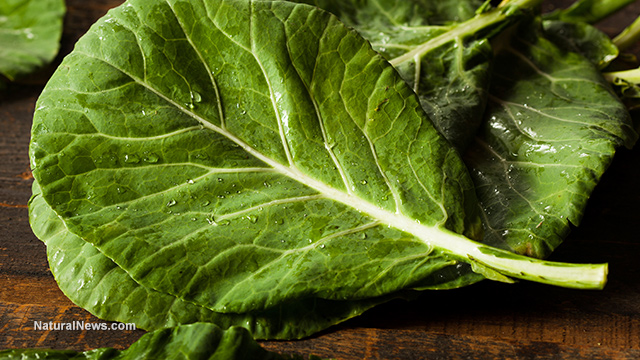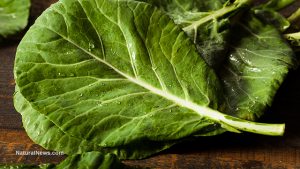
Collard Greens – sources, health benefits, nutrients, uses and constituents at NaturalPedia.com
Wednesday, June 21, 2017 by Frances Bloomfield
http://www.naturalpedia.com/collard-greens-sources-health-benefits-nutrients-uses-and-constituents-at-naturalpedia-com.html

Collard greens are dark-colored, leafy green vegetables belonging to the Brassica family, a group that includes broccoli and cabbage among its members. East Africa, South America, Southern Europe, and the Southeastern United States are regions that count collard greens as a staple vegetable in their diets. Collard greens are famous for being nutritionally dense and very low in calories.

List of known nutrients
Collard greens have impressive amounts of vitamin K and vitamin A, or beta-carotene: 100 leaves can provide up to 370 percent of the daily recommended value of vitamin K, while 100 g can deliver 170 of the recommended daily allowance of vitamin A. Far from being the only nutrients, collard greens have a wide variety of vitamins, minerals, and phytonutrients:
- Calcium
- Choline
- Copper
- Folates
- Glucosinolates
- Iron
- Lutein
- Manganese
- Phosphorus
- Selenium
- Sulforaphane
- Vitamin B2 (Riboflavin)
- Vitamin B3 (Niacin)
- Vitamin B5 (Pantothenic acid)
- Vitamin B6 (Pyridoxine)
- Vitamin C
- Vitamin E
- Zinc
Medicinal uses for collard greens
These cruciferous vegetables can reduce the risk of many health conditions, both lifestyle-related and genetic. Among these ailments are:
- Acne
- Cancer
- Cataracts
- Constipation
- Diabetes
- Hair loss
- High blood pressure
- Immune system deficiency
- Inflammatory bowel disease
- Irritable bowel syndrome
- Muscular degeneration
- Rheumatoid arthritis
- Skin disorders
- Ulcerative colitis
Vitamin K, the most abundant vitamin in collard greens, lessens the risk of bone fractures by improving calcium absorption, modifying bone matrix proteins, and reducing urinary excretion of calcium. Just one cup of collard greens can provide over 770 micrograms or over 100 percent of the recommended daily intake.
Collard greens can maintain healthy skin and hair. Vitamin A, a vitamin collard greens have in generous amounts, is essential for the growth of skin and hair. Moreover, vitamin A is also necessary for the production of sebum, a substance that keeps the hair moisturized. Vitamin C is needed for collagen building and maintenance, and is found in collard greens.
Collard greens offer exceptional cardiovascular support. The fiber-related nutrients in collard greens can lower cholesterol, while glucosinolates trigger anti-inflammatory activity in the cardiovascular system.
Because collard greens are rich in vitamin K, they should be carefully monitored by individuals taking blood thinners. This vitamin plays a major role in blood clotting, and suddenly decreasing or increasing the intake of collard greens could influence the effects of the blood thinners. Individuals with thyroid dysfunction should avoid collard greens. Similar to other members of the Brassica family, collard greens may contain goitrogens, substances that cause the thyroid gland to swell.
Body systems supported by collard greens
Their wealth of nutrients makes collard greens a great addition to nearly any diet. Incorporating them into daily meals can give the following organs or systems welcome support:
- Bones
- Digestive System
- Heart
- Immune System
- Skin and Hair
Ways to use collard greens
As a vegetable that’s regularly eaten in multiple parts of the world, there are scores of recipes that use collard greens. From Africa, there’s ye’abesha gomen or collard greens cooked with Ethiopian-style spiced butter, cardamom, fenugreek, and nigella seeds. From Brazil, there’s sopa de fuba, a soup made from collard greens, cornmeal, and sausage. A soft-shell crab sandwich, a classic sandwich from the East Coast, can be made more flavorful with a collard greens slaw.
Where to learn more
- Collard greens: the new kale?
- Top 5 Non-Dairy Sources of Calcium
- Natural Ways to Boost Your Hair’s Health
- 5 Vital Vegetarian Tips
- Top Ways Cruciferous Vegetables Helps Fight Cancer
Summary
Collard greens lessen the risk of bone fractures due to their high vitamin K content.
These leafy vegetables are also an excellent source of vitamin A, making them essential for healthy skin and hair.
Collard greens help support the cardiovascular system.
Due to their high vitamin K content, collard green consumption should be carefully monitored, especially for those on blood thinners.
Sources include:
WHFoods.org
Nutrition-And-You.com
Saveur.com
StyleCraze.com
MedicalNewsToday.com
Tagged Under: Tags: Collard greens





